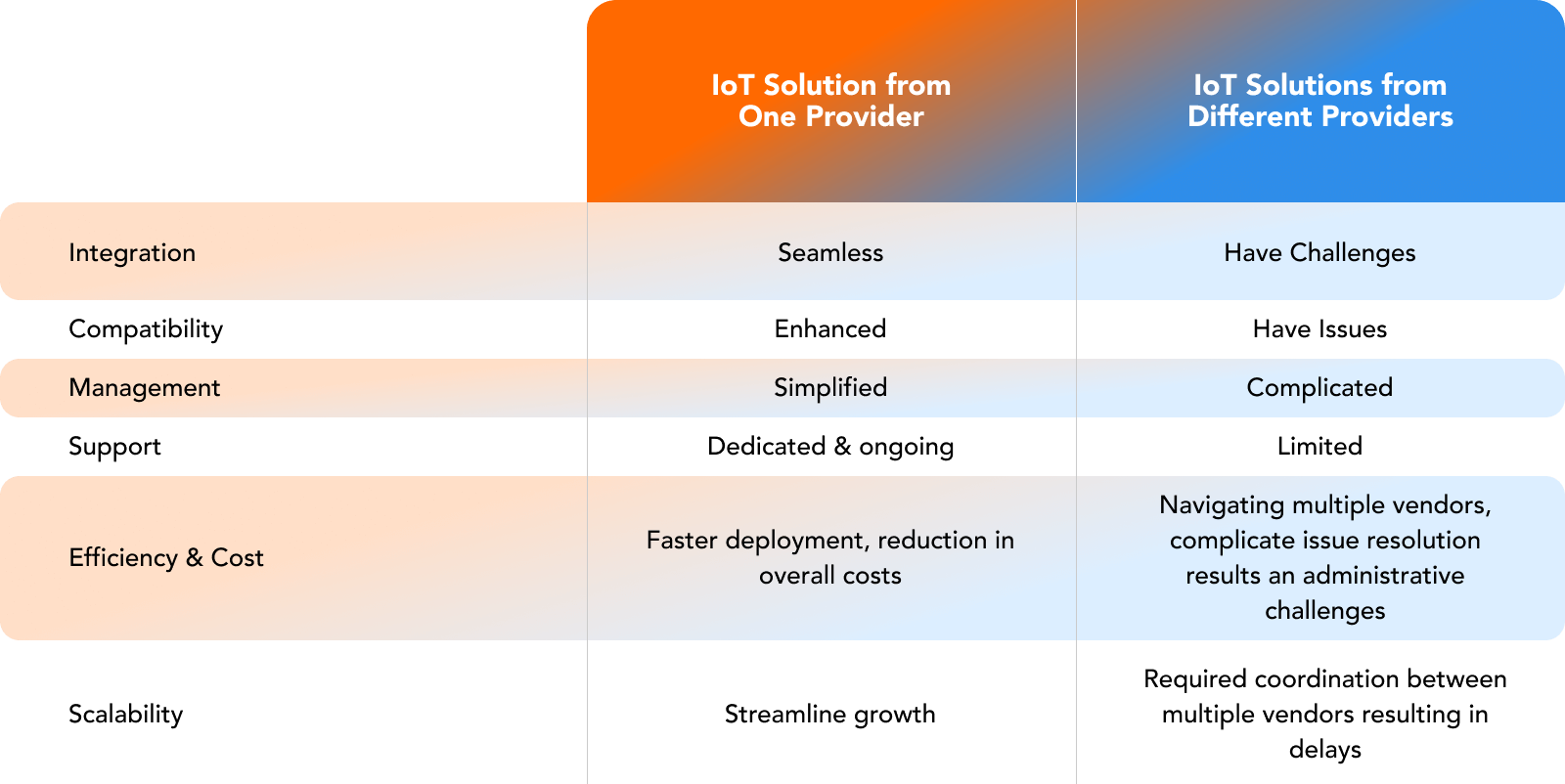The rise of the Internet of Things (IoT) has sparked a revolution across various industries, empowering businesses to achieve unprecedented levels of productivity, gain invaluable insights, and introduce groundbreaking services. In this ever-evolving landscape, two technologies have emerged as true game-changers for IoT applications: LoRaWAN and cellular connectivity.
Both of these cutting-edge technologies offer unique benefits that significantly enhance IoT implementation, enabling businesses to maximize the potential of their projects and unlock a world of new possibilities.
By harnessing the potential of both LoRaWAN technology and cellular connectivity, businesses can tap into a world of endless possibilities. LoRaWAN, a cutting-edge network protocol designed for long-range, low-power communication in IoT applications, becomes even more powerful when combined with cellular connectivity. This strategic integration opens up new doors for businesses, allowing their IoT devices to connect over larger geographic areas by leveraging the expansive coverage of cellular networks. Even in the face of challenges such as LoRaWAN connection issues or local network problems, data can still be seamlessly transmitted. With this dynamic combination, businesses can overcome connectivity obstacles and ensure the success of their IoT projects.
When it comes to choosing a cellular connectivity provider for IoT projects, businesses often face the question of whether to opt for a single provider or multiple providers.
While in most cases it is recommended to obtain cellular connectivity for LoRaWAN from a single provider, there are situations where obtaining connectivity from multiple providers can be beneficial. This approach allows businesses to optimize coverage, redundancy, and take advantage of specific network capabilities. To determine the most suitable approach, businesses can consult with IoT experts or various providers.
In this article, we will dive into a common situation and uncover the advantages of opting for a single provider that offers a comprehensive solution for both LoRaWAN and cellular connectivity. Furthermore, we will explore the difficulties that arise when sourcing and integrating these solutions separately from various companies.
Benefits of a one-package solution
- Seamless Integration: By opting for a single provider that offers both LoRaWAN and cellular connectivity, businesses can experience a seamless integration process. This means that they will receive a pre-integrated and thoroughly tested solution, eliminating the complexities that come with integrating components from multiple providers. The combined solution ensures flawless compatibility and communication between the LoRaWAN and cellular networks, streamlining implementation and minimizing any integration challenges that may arise.
- Effortless Deployment: Opting for a single provider for your connectivity solution ensures a hassle-free deployment process. The provider offers comprehensive support, taking care of network setup, device provisioning, and activation. This seamless integration of all solution components guarantees a swift and efficient deployment, eliminating the need to coordinate with multiple providers.
- Simplified Management and Support: By choosing a combined solution from a single provider, businesses can benefit from centralized management and support. With their extensive knowledge of the solution architecture, the provider can offer dedicated assistance for both LoRaWAN and Cellular components. This simplifies the troubleshooting process, streamlines maintenance, and ensures faster issue resolution, all while reducing complexities. Plus, businesses only need to communicate with one contact, making management more efficient and effective.
- Enhanced Compatibility and Optimization: Opting for a combined LoRaWAN and Cellular connectivity solution from a single provider unlocks seamless compatibility. The provider has fine-tuned their solution to deliver peak performance, efficiency, and reliability. By harnessing their integrated solution, businesses can tap into their expertise in optimizing the interaction between the LoRaWAN and Cellular networks. This leads to enhanced performance, improved compatibility, and an elevated user experience.
- Cost Savings and Efficiency: Having a unified solution from a single provider not only enhances cost savings but also boosts operational efficiency. By combining LoRaWAN and Cellular connectivity, the provider can optimize their pricing structure, potentially offering attractive discounts or cost-effective packages. Consolidating services with one provider minimizes administrative and management burdens, resulting in overall efficiency improvements and potential long-term cost reductions.
- Future Scalability and Upgrades: To ensure the success and scalability of IoT deployments, it is crucial to plan for future growth and upgrades. By opting for a comprehensive solution from a single provider, businesses can harness the power of seamless expansion, increased capacity, and integration of emerging technologies. This future-proofing capability, guided by the expertise of one provider, paves the way for uninterrupted growth and ensures that IoT deployments remain agile and adaptable to changing needs.
Disadvantages of separate solutions
To get a comprehensive understanding, let's explore the drawbacks of sourcing LoRaWAN and Cellular connectivity solutions from different providers.
- Integration Challenges: Obtaining LoRaWAN and Cellular connectivity solutions from separate providers can pose challenges in terms of integration. These challenges arise due to variations in protocols, APIs, and compatibility requirements, which make it difficult to seamlessly align the two networks. As a result, integration may become a complex and time-consuming process, requiring additional effort, resources, and expertise to ensure proper interoperability and communication between the networks.
- Compatibility Issues: Opting for separate providers for LoRaWAN and Cellular networks can introduce compatibility hurdles. Discrepancies in specifications, configurations, or firmware versions may impede smooth connectivity and hinder reliable data transmission. These compatibility issues can give rise to connectivity problems, data loss, or decreased performance, ultimately compromising the effectiveness and dependability of the IoT solution.
- Increased Complexity and Management Overhead: Managing multiple providers for LoRaWAN and Cellular connectivity solutions can introduce a multitude of complexities and challenges. With each provider having their own unique processes, support structures, and communication channels, it becomes necessary to engage in separate interactions and coordination. As a result, this can potentially lead to administrative difficulties, delays in issue resolution, and even miscommunication or misunderstandings between providers, ultimately resulting in inefficiencies and extended timelines.
- Limited Support and Responsibility: Having separate solutions for support and issue resolution can be a major drawback, as it divides responsibility among different providers. This can lead to challenges in identifying the responsible party for addressing problems, resulting in delays and potential finger-pointing. The fragmented support structure can ultimately cause prolonged downtime, impacting the overall operation of the IoT deployment and hindering its smooth functioning.
- Increased Cost and Potential Inefficiencies: Obtaining separate solutions from different providers can result in higher expenses and potential inefficiencies. Each provider may have their own pricing structures that may not align with a combined solution, leading to increased costs compared to a bundled package from a single provider. Additionally, managing multiple contracts, invoices, and billing processes from different providers can create administrative burdens and inefficiencies in cost management and tracking.
- Limited Future Scalability and Optimization: Choosing separate solutions for the IoT deployment can hinder its potential for growth and advancements. Varying plans, timelines, and upgrade cycles from different providers can introduce inconsistencies and delays when expanding or enhancing the IoT solution. This fragmented approach limits future scalability and impedes the utilization of emerging technologies and features.
To summarize, opting for a unified solution from a single provider offers significant time and cost savings. It streamlines management and operation, effectively reducing the complexities and risks associated with sourcing and integrating components from multiple providers. This all-in-one approach proves to be highly practical and efficient for IoT deployments, offering a multitude of benefits.

POND IoT Brings It All Together
LoRaWAN and cellular connectivity play a vital role in enhancing network coverage and connectivity for IoT devices. POND offers SMART SIM cards that improve network signal availability, especially in remote areas or regions with limited coverage. These Multi-IMSI SIM cards can connect to multiple service providers, automatically switching to alternative networks if the primary one is weak or unavailable. This ensures uninterrupted communication and access to mobile services.
For IoT devices operating globally, these SIM cards provide the necessary flexibility. They allow seamless switching between multiple IMSIs, enabling IoT devices to connect to local networks in different regions without requiring complex configurations or manual SIM replacements. This ensures reliable connectivity as IoT devices move across geographic boundaries.
In terms of security, multi-IMSI SIM cards prioritize data protection and secure communication. They incorporate authentication and encryption protocols to safeguard IoT data and facilitate secure connections between devices and the network. By using multi-IMSI SIMs, IoT deployments benefit from enhanced data privacy, authentication mechanisms, and secure network connections, mitigating potential security risks and ensuring the integrity of transmitted information.

